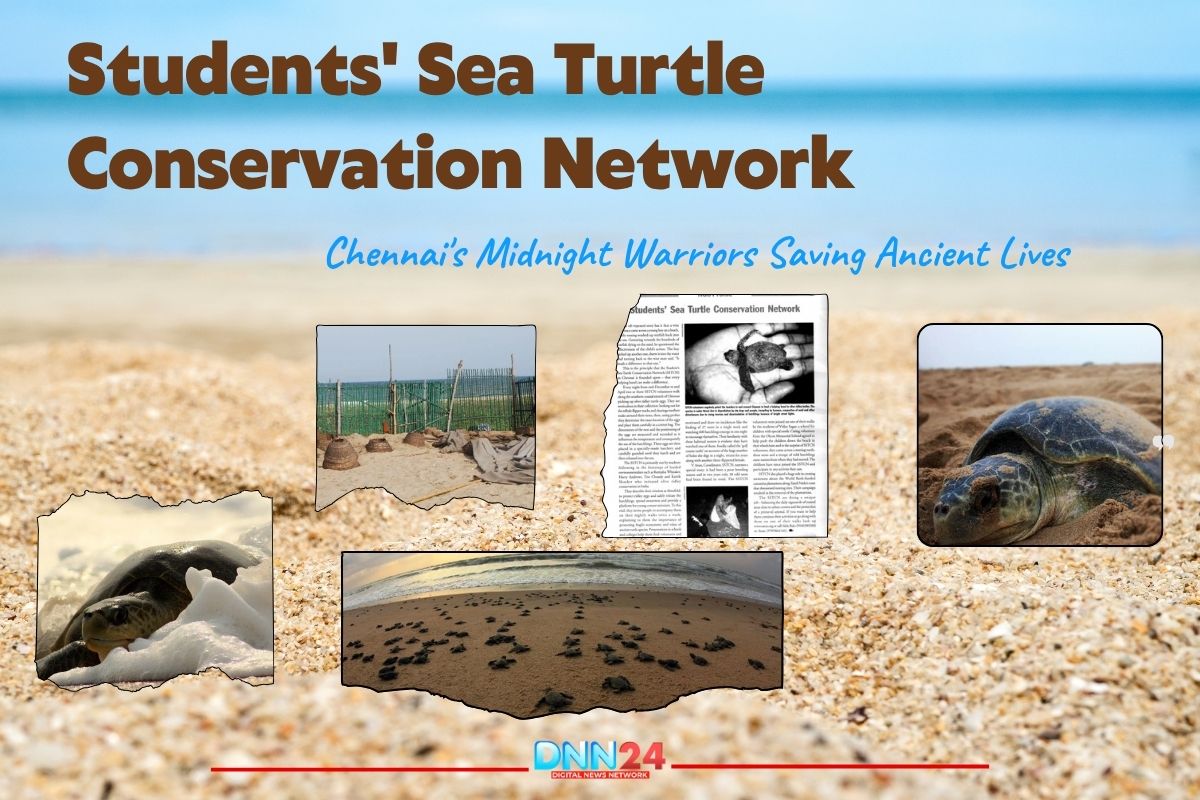What drives a group of college students to abandon their warm beds at midnight and walk seven kilometers along Chennai’s coastline? The Students’ Sea Turtle Conservation Network has an answer that might surprise you. For over three decades, this remarkable organization has turned ordinary students into guardians of creatures that have existed for 100 million years. Between January and April, when most people are deep in sleep, these young volunteers patrol the stretch from Neelangarai to Besant Nagar with flashlights and determination, searching for something precious: Olive Ridley turtle eggs buried in the sand.
Anirudh, a core volunteer, vividly remembers his first night. “I thought we would just walk around and maybe spot a turtle. But when I saw a mother Olive Ridley digging her nest, everything changed. That moment stays with you forever.” The process is delicate and urgent. Once eggs are discovered, volunteers work alongside Forest Department officials to carefully transport them to protected hatcheries.
After 45 days of incubation, tiny hatchlings emerge and begin their perilous journey to the ocean. “Every egg we save feels like a small victory against extinction,” explains Divya, who has been volunteering for two years despite her demanding university schedule. The nesting season is brief but intense, and the team knows that missing even one night could mean losing precious lives to predators, poachers, or careless beach goers who unknowingly destroy nests.
Students’ Sea Turtle Conservation Network Voices from the Sand: Stories That Changed Everything
Why would anyone choose sleepless nights over comfort? The volunteers of Students’ Sea Turtle Conservation Network have stories that explain their devotion better than any mission statement could. Preeti joined three years ago after reading about declining turtle populations. “I felt this guilt, you know? These animals survived the dinosaurs, and now we might be the generation that watches them disappear. I could not just sit and read about it.” Her first walk was challenging. The distance seemed endless, her legs ached, and doubt crept in. However, the group then discovered a nest. “Watching everyone work together, seeing those eggs, it hit me that this matters. Really matters.”
Divya faced different obstacles. Her friends called her crazy for spending her weekends on the beach instead of at parties. “They laughed when I talked about conservation. Some said I was wasting my youth on turtles.” The mockery stung, but she persisted. Months later, her determination paid off in unexpected ways. Two friends who had ridiculed her the most asked to join a walk. “They came out of curiosity, but they stayed because they felt it.
That connection to something bigger.” Now, pollution remains their biggest enemy; plastic bags mistaken for jellyfish, fishing nets, and coastal development are the threats that never stop. Arun, who writes poetry about his experiences, describes the emotional toll that his experiences have taken on him. “Some nights we find destroyed nests. You feel helpless and angry. But then you remember the hatchlings that made it because of us, and you keep going.” The group has become his second family, a support system where everyone understands the struggle and shares the mission.
Students’ Sea Turtle Conservation Network: Seven Kilometres of Purpose Under the Stars
The Neelangarai gathering point buzzes with quiet energy as volunteers assemble around midnight. Fifty students, some veterans and some newcomers, prepare for the long walk ahead. Before starting, group leaders conduct brief sessions covering turtle biology, current environmental threats, and practical conservation methods. These discussions are not lectures, but rather conversations where everyone contributes their observations and questions. Laughter mingles with serious debate as the group bonds before the patrol begins. The route to Besant Nagar covers seven kilometers of shoreline, each stretch holding possibilities.
Chaitanya describes the actual walk as meditative. “You become hyper-aware of everything. The sound of waves, shadows on the sand, any disturbance that might indicate a nesting turtle.” Silence falls when a turtle is spotted. The group maintains a respectful distance, allowing nature to proceed undisturbed while documenting the nesting process. “Watching a turtle lay eggs is surreal. This ancient ritual happening right before your eyes, it humbles you completely,” he says. Newcomers often struggle with exhaustion around the halfway point, but experienced volunteers encourage them to move forward.
Diya, a three-year veteran, notes how the walks forge unexpected friendships. “You spend hours walking, talking about everything from climate change to personal dreams. My closest friends today are people I met on these patrols. There is something about shared purpose that creates real bonds.” Dawn breaks as the group completes their circuit, gathering to share observations and stories. For practical details, reach Neelangarai by turning onto the ECR next to Shanthi Hospital, under the Kapaleeswar Nagar arch, with parking available at Elliots Beach for a convenient return.
Students’ Sea Turtle Conservation Network: Your Invitation to Join History in Motion
Students’ Sea Turtle Conservation Network operates on a simple belief: conservation is not reserved for scientists or experts but belongs to anyone willing to care. The organization welcomes students from all backgrounds, whether you study biology, literature, engineering, or the arts. January through March offer patrol opportunities, while March and April provide chances to witness hatchling releases, moments that volunteers describe as magical and emotional. “Watching dozens of tiny turtles scramble toward the ocean, knowing they might return decades later to nest on the same beach, that stays with you forever,” says Preeti.
The network needs more than just walkers. Writers document experiences for awareness campaigns, artists create visual materials for education programs, and photographers capture moments that tell powerful stories. “Your skills matter here, whatever they are,” Arun emphasizes. “I never thought my poetry would help conservation, but now my verses are read in schools across Chennai.” The commitment required is flexible. Some volunteers attend every walk during the season, while others join occasionally, balancing their participation with exams and family obligations. What matters is the willingness to contribute.
Imagine being part of a movement that connects you to ancient creatures, passionate peers, and a cause that transcends individual lives. The struggles are real: sleepless nights, academic pressure, and emotional exhaustion when efforts fail. But so are the rewards: friendships forged in shared mission, personal growth through challenges overcome, and the profound satisfaction of making a tangible difference. Students’ Sea Turtle Conservation Network has space for everyone who wants their life to mean something beyond routine. Your story could begin where sand meets water, under stars that have watched these turtles for millions of years, among friends who will become family through shared purpose and late-night conversations about hope and resilience.
Also Read: Pad Squad: Spreading Menstrual Dignity Across India’s Communities
You can connect with DNN24 on Facebook, Twitter, and Instagram and subscribe to our YouTube channel.

